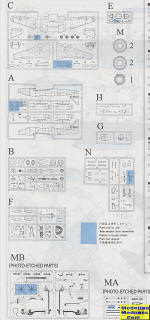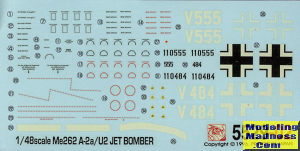
| KIT #: | 5529 |
| PRICE: | $ |
| DECALS: | Two options |
| REVIEWER: | Scott Van Aken |
| NOTES: | 1996 release |

| HISTORY |
The Messerschmitt Me 262, nicknamed Schwalbe (German: "Swallow") in fighter versions, or Sturmvogel (German: "Storm Bird") in fighter-bomber versions, was the world's first operational jet-powered fighter aircraft. Design work started before World War II began, but problems with engines, metallurgy and top-level interference kept the aircraft from operational status with the Luftwaffe until mid-1944. The Me 262 was faster and more heavily armed than any Allied fighter, including the British jet-powered Gloster Meteor. One of the most advanced aviation designs in operational use during World War II, the Me 262's roles included light bomber, reconnaissance and experimental night fighter versions.
Me 262 pilots claimed a total of 542 Allied aircraft shot down, although higher claims are sometimes made. The Allies countered its effectiveness in the air by attacking the aircraft on the ground and during takeoff and landing. Strategic materials shortages and design compromises on the Junkers Jumo 004 axial-flow turbojet engines led to reliability problems. Attacks by Allied forces on fuel supplies during the deteriorating late-war situation also reduced the effectiveness of the aircraft as a fighting force. Armament production within Germany was focused on more easily manufactured aircraft. In the end, the Me 262 had a negligible impact on the course of the war as a result of its late introduction and the consequently small numbers put in operational service.
While German use of the aircraft ended with the close of World War II, a small number were operated by the Czechoslovak Air Force until 1951. It also heavily influenced several designs, such as Sukhoi Su-9 (1946) and Nakajima Kikka. Captured Me 262s were studied and flight tested by the major powers, and ultimately influenced the designs of post-war aircraft such as the North American F-86 Sabre, MiG-15 and Boeing B-47 Stratojet. Several aircraft survive on static display in museums, and there are several privately built flying reproductions that use modern General Electric J85 engines.
The 262 was heavily prototyped, resulting in many possible variants that never made it beyond the prototype stage. One of those was the Me-262A-2a/U2, two prototypes of which were built with glazed nose for accommodating a bombardier. It was felt that a dedicated bombardier would get better results from bombing than just the pilot alone. It was planned on the aircraft being used as the 'master bomber' in an attack group.
| THE KIT |
 For
a while, Dragon/DML was very much into doing model airplane kits. That has waned
considerably when they realized that the real cash cows was armor kits. Even so,
the 262 series engendered half a dozen variants that used a lot of the same
sprues. The same can be said about this particular kit. It is basically a 262A
with a new nose section. Fortunately, Dragon designed the fuselage so that it
could deal with this new nose without making a separate nose section so there is
no seam.
For
a while, Dragon/DML was very much into doing model airplane kits. That has waned
considerably when they realized that the real cash cows was armor kits. Even so,
the 262 series engendered half a dozen variants that used a lot of the same
sprues. The same can be said about this particular kit. It is basically a 262A
with a new nose section. Fortunately, Dragon designed the fuselage so that it
could deal with this new nose without making a separate nose section so there is
no seam.
The cockpit is standard fare with raised instrument panels and etched belts for the pilot's seat. The cockpit tub is a properly shaped unit into which yhou install all the proper controls, some of them in photo etch. A separate nose gear well fits onto the forward bulkhead where the guns used to go and if you are going to use a crew figure in the nose you need to add it early. This crew member gets no belts so one wonders how he would hang on if the pilot had to do some heavy maneuvering to escape fighters. There is an upper hatch that can be posed open and a new clear nose section. There are two different optional blisters for the nose depending on which of the two prototypes you are modeling.
Dragon wants you to instal the nose gear assembly and doors at this point, but you can hold off until after painting. Next, the main gear well is built up and some of the photo etch fits here. This is then trapped between the wing sections and installed on the fuselage as are the horizontal stabs and rudder. This is also when the nose probes and windscreen are attached. This is followed by the main gear and legs. Note that the tires and wheel halves are separate on all wheels to help facilitate painting. Again, you can leave this off until after painting.
It is only now that the engines are built up and installed. The rest of the upper cockpit is then assembled. This includes a fair number of p.e. bits for the canopy, which can be posed open or closed. Last part is the installation of the bomb racks and the bombs. Holes need to be drilled for the racks and you are provided a guide as to where to drill the holes.
 Instructions
are well done with Gunze paint references. Though only markings placement for
V555 is shown, both aircraft are painted the same. Dragon says they should be
olive drab over light blue. I suspect this should be RLM 81 over RLM 76. Decals
are nicely done and printed in Japan. This means the whites are actually
off-white. A lack of aftermarket for this variant means you'll need to use them.
Instructions
are well done with Gunze paint references. Though only markings placement for
V555 is shown, both aircraft are painted the same. Dragon says they should be
olive drab over light blue. I suspect this should be RLM 81 over RLM 76. Decals
are nicely done and printed in Japan. This means the whites are actually
off-white. A lack of aftermarket for this variant means you'll need to use them.
| CONCLUSIONS |
When these kits were released, the only other 1/48 262s were by Lindberg and Monogram. While those are still pretty nice kits, this one was miles ahead in terms of detailing. They will still give the more recent Hobby Boss kits a run for the money and can generally be found at favorable prices on various sales pages. Though the small bits means a fairly fiddly build, the end results should be well worth the effort.
| REFERENCES |
https://en.wikipedia.org/wiki/Messerschmitt_Me_262
October 2020 Copyright ModelingMadness.com. All rights
reserved. If you would like your product reviewed fairly and fairly quickly, please
contact
the editor or see other details in the
Note to
Contributors.
Back to the Main Page
Back to the Review
Index Page
Back to the Previews Index Page